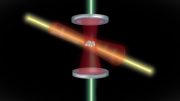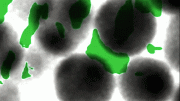
Far-UVC light has proven highly effective in real-world settings at inactivating over 99% of airborne viruses in occupied spaces, as demonstrated by a Columbia University study, offering a practical and continuous disinfection solution that could surpass conventional ventilation systems in preventing airborne disease transmission. This technology, safe for human exposure, represents a significant advancement over traditional germicidal UVC methods, which require empty spaces to operate. Credit: SciTechDaily.com
Far-UVC light holds potential as an innovative approach to lower airborne virus concentrations in occupied indoor settings, yet its real-world efficacy remains unassessed.
A new study by Columbia researchers now shows that far-UVC light inactivated nearly all (>99%) of an airborne virus in an occupied work environment, showing that the technology can work as well in a real-life scenario as in the laboratory.
“The results show that far-UVC is highly effective at reducing airborne pathogens in an ordinary occupied room, and so it’s practical to use far-UVC light in indoor areas where people are going about their business,” says David Brenner, Ph.D., director of the Center for Radiological Research at Columbia University Vagelos College of Physicians and Surgeons and senior author of the study.
“If this virus had been a disease-causing virus, the far-UVC light would have provided far more protection against airborne-disease transmission than any ventilation system,” says Brenner.
A new air disinfection technology
Conventional germicidal UVC light is a well-known technology for killing viruses and bacteria and is frequently used by hospitals to sterilize rooms. However, direct exposure to conventional germicidal UVC light can potentially harm skin and eyes, so it can only be turned on when a room is empty.
“You can decontaminate a room in the morning before people arrive, but it can quickly become contaminated again because people in the room are shedding viruses and other airborne pathogens,” Brenner says. “The goal is to be able to continuously decontaminate a room while people are in it.”
Over the past few years, Brenner’s team has been developing far-UVC light, which has a shorter wavelength (222-nm) than conventional germicidal UVC light and cannot penetrate or damage living skin or eyes. Laboratory tests at Columbia and other centers have demonstrated that far-UVC quickly and efficiently inactivates airborne pathogens in both small and room-sized test chambers.
A real-world test
In the new study, the researchers wanted to look at the impact of far-UVC light in a room where both people and high levels of virus in the air are present. For ethical and safety reasons, the virus had to be harmless to humans.
At Columbia, a room where laboratory mouse cages are cleaned provided an ideal test setting. Most mice carry a form of norovirus that doesn’t make the animals—or humans—sick, but high concentrations of the virus become airborne when the cages are cleaned.
The researchers installed four overhead far-UVC lamps in the cage cleaning room and collected daily air samples to compare infectious virus levels on days when the lamps were turned on and days when the lamps were turned off. (The lamps were in compliance with current regulatory guidance on far-UVC exposure limits.)
Efficacy surpassed expectations
“Based on our initial sensitivity tests, we expected to see a reduction in airborne virus of around 66%,” says Brenner. The result—a reduction in infectious airborne viruses of 99.8%—surpassed expectations and was far greater than what could be achieved by typical air filtration and ventilation.
The study did not find any measurable difference in air quality (ozone or particulates) associated with far-UVC illumination.
Next steps
Far-UVC lamps are being installed in more public locations, with corresponding measurements of the reduction in airborne pathogens.
Brenner’s team is also performing laboratory studies to directly quantify the effect of far-UVC light on airborne disease transmission.
Reference: “222 nm far-UVC light markedly reduces the level of infectious airborne virus in an occupied room” by Manuela Buonanno, Norman J. Kleiman, David Welch, Raabia Hashmi, Igor Shuryak and David J. Brenner, 20 March 2024, Scientific Reports.
DOI: 10.1038/s41598-024-57441-z
The study was funded by Good Venture Foundation Open Philanthropy.









Of course…and ozone generation will kill you before you can smell it.
Can you be more precise about your concern? The article specifically said, “The study did not find any measurable difference in air quality (ozone or particulates) associated with far-UVC illumination.” I have experienced the smell of ozone generated by electrical discharges, and particularly from 254nm Hg-vapor UV bulbs, frequently, throughout my adult life. I’m still alive and probably older than you are.
This is seriously old news, anyway:
https://www.ncbi.nlm.nih.gov/pmc/articles/PMC9437662/